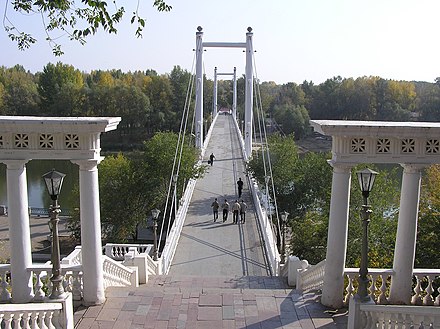Orenburg - city in the south of Russia
Orenburg (Russian: Оренб'ург, Uh-rehn-BOORK) is the capital of Orenburg Oblast. Every citizen will point you the sign at the bridge across the Ural river, supposedly landmarking the geographical border between Europe and Asia (the actual boundary is further east). Orenburg has a sizable Turkic population, which gives to the city a bit of a Central Asian colour.
Understand
 The bestowing of a German name ("eastern walled town") on a brand new Russian fortress city would not sound unusual in 1743, when German-born nobles played a significant role in the Russian Empire. The chosen place, where the Or and the Ural rivers join, was the Empire's eastern border at the time.
The bestowing of a German name ("eastern walled town") on a brand new Russian fortress city would not sound unusual in 1743, when German-born nobles played a significant role in the Russian Empire. The chosen place, where the Or and the Ural rivers join, was the Empire's eastern border at the time.
Orenburg played a major role in Pugachev's Rebellion (1773–1774), the largest peasant revolt in Russian history. It was then a capital of a vast district, the seat of a Governor. Yemelyan Pugachev besieged the city and its fortress from nearby Berda from October 1773 to March 26, 1774. The defense was organized by Governor Lieutenant-General Reinsdorf. Most of the city was left in ruins, and thousands of inhabitants died in the siege. Imperial forces crushed the revolt towards the end of 1774.
Orenburg was the base for General Perovsky's expeditions against the Khanate of Khiva in the 1830s through 1850s. As Central Asia was absorbed into the Russian Empire, Orenburg became a trading station and, since the completion of the Trans-Aral Railway, a prominent railway junction en route to the new Central Asian possessions and to Siberia.
Alexander Pushkin visited Orenburg in 1833, during a research trip for "The History of Pugachev" and his novel "The Captain's Daughter", whose themes famously overlap. Here he met his friend Vladimir Dal, who would later write the first serious dictionary of the Russian language.
Orenburg functioned as the capital of the Kirghiz Autonomous Soviet Socialist Republic (in present-day Kazakhstan) within Russia from 1920–1925. When that republic was renamed Kazak Autonomous Soviet Socialist Republic in 1925, Orenburg joined Russia.
From 1938 to 1957, the city bore the name Chkalov (Чка́лов), after the prominent test pilot Valery Chkalov. The city's distance from the German invasion during World War II led many Soviet enterprises to relocate here, helping to spur the city's economic growth.
Climate
Orenburg has a relatively dry humid continental climate with quite long and hot summers and long and cold winters. April and October are transition months, with the rest of the months being either summer or winter.
Get in
By plane
- Airport "Tsentralny" (IATA: REN, Russian: Аэропорт Оренбург), 51.795786°, 55.456744°, +8 3532 676-544. It serves flights from Moscow, Saint Petersburg, Magnitogorsk, Hannover, Dusseldorf, Yerevan and other cities. 2020-03-30
By train
The Orenburg station is a part of South-Ural Railway and its network is connected by direct trains to Moscow, Samara, Ufa, Yekaterinburg, Kyiv and southern capitals of the CIS republics.
- Orenburg railway station, 51.776292°, 55.074756°. 2020-05-20
Get around
City public transport includes bus, trolleybus and also marshrutkas (fixed-route cabs).
See
The remnants of the old fort and its gate constructed in 1743 should be seen first.
Museums
- Museum of city's history. The gothic building with tower and clock.
- Museum of regional studies.
- Museum of arts.
- Museum of Rostropovich family.
- Museum-flat of the first cosmonaut Yuri Gagarin and his family.
- Museum "Memory House".
Temples
- St. Nikolai Cathedral.
- Mosque "Karavan Sarai". Built in 1836-42 by the project of Alexander Brullov.
- Orthodox Church of Sergius of Radonezh.
Other
- Frunze Garden (Городской сад им. Фрунзе), ul. Kirova 1, 51.7588446°, 55.0941577°. Public garden set up as an open-air military museum, with airplanes, tanks, trucks and artillery pieces of all sizes. 2020-03-30
- National village - collection of traditional houses in styles of local peoples: Russian, Tatar, German, Kazakh, Bashkir, Ukrainian,Chuvash, Azerbaijani and Belarusian.
- Central exposition hall of the Union of Artists.
- Zauralnaya roscha. (Ural woods)- the forest-park in the city limits.
- Memorials to Peter the Great and pioneer aviator Valery Chkalov. Both feature nice views of the Ural river.
Do
Buy
Orenburg is famous for its shawls, known as Orenburg shawls/scarves or wedding ring shawls.
- Tsum Orenburg (ЦУМ Оренбург), 20 ul. Volodarskogo, 51.7654759°, 55.0927636°, +7 353 277-49-44. Shopping mall. 2020-03-30
- Gostiny Dvor Mall (Гостиный двор), 13 ul. Kirova, 51.7613998°, 55.0940707°, +7 353 277-76-99. 2020-03-30
- Armada Mall, 1, Shalykskoye shosse, 51.8448623°, 55.1205503°. 2020-03-30
Eat
- Kruzhka (Кружка), 20 Chicherina st, 51.7578404°, 55.0881931°, +7 353 240-09-60. Casual Russian food.
Drink
- Local beer and kvas Gofman
Bars
- Dublin Irish pub, 24 Krasnoznamennaya st..
Sleep
- Yaik Hotel, Ulitsa Energetikov, 7Е, +7 353 268-68-68. Indoor pool and sauna; breakfast. A modern looking block type building. 1473 руб
- Hotel Mia, Proletarskaya Ulitsa, 89, +7 353 293-60-00. Has an indoor pool and kind of looks like a wedding chapel.
- Don Quixote Hotel.
- Hotel Briz.
- Hotel Dubrava plus, Ulitsa Aksakova, 20б, +7 353 261-27-27. Modern hotel with complimentary breakfast.
Connect
Go next
Orenburg
orenburg.ruOrenburg Oblast
Primary administrative division